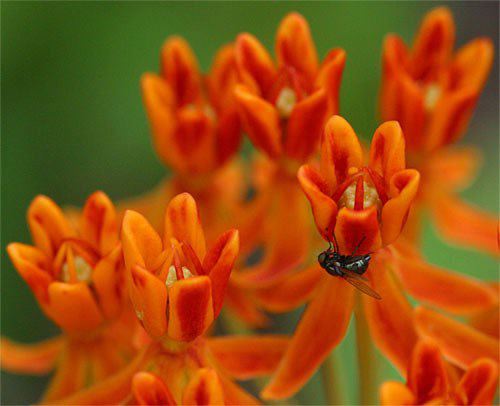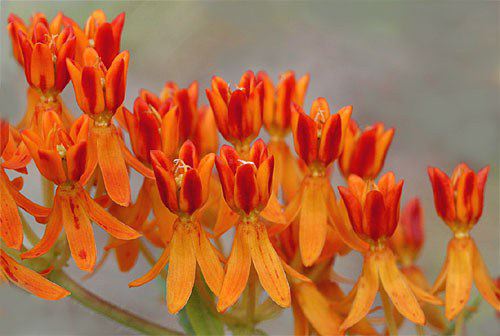|
|
|||
|
|
|||
THIS WEEK at HILTON POND
22-30 June 2003
Back to Preceding Week; on to Next Week
|
MUST BE FLY-WEED. OR BEE-WEED. One of the best things about bicycling is that it allows one to sample the world in ways unimaginable to those who travel highways only at 60 miles per hour in air-conditioned vehicles with windows closed and the stereo cranked as high as it can go. For more than 30 years we have found great pleasure in pedaling back roads of the Carolina Piedmont, sniffing the essence of summer wildflowers, occasionally hopping off the bike to help a turtle get to the other side, and generally getting a slower-paced view of nature while we work on our cardiovascular fitness. We've seen lots of interesting sights while bicycling, but this week were so pleased at something growing along the roadside that--after riding back to Hilton Pond Center--we grabbed our camera equipment and drove out for a closer view.  All text & photos © Hilton Pond Center What caught our attention was a large patch of orange-red flowers growing on the shoulder scarcely a quarter-mile from Hilton Pond. As we approached the colony and placed the digital camera on a tripod, we noticed really tiny greenish flies among the quarter-inch-wide flowers (above), and quickly snapped a few exposures as one tried to steal nectar from a gap between petals. Despite the flies, we knew this wasn't "Fly-Weed," and the presence of large numbers of industrious and surprisingly docile Honeybees (below right) didn't mean it was "Bee-Weed," either. Butterfly-weed has always been one of our favorite native wildflowers, in part because it contrasts so brightly with the green grasses and shrubs that grow beside our highways. We also like it because it is, indeed, a magnet for insects, and we've spent numerous hours counting how many different kinds of bugs, beetles, butterflies, and bees would land on a particular cluster of flowers. Butterfly-weed likes full sun, so it's no wonder it does well along the right-of-way--at least until the friendly but single-minded maintenance folks come by and mow it down on the shoulder or median. Miraculously, roadside mowing seems to have done a favor for the plants we discovered this week. Butterfly-weed grows in open places--including prairies and fields--from the Rockies eastward; local forms can vary greatly in length of stem and hue of flower, from yellow to orange to red. Although Butterfly-weed is actually in the Milkweed Family (Asclepiadaceae), it's a species that doesn't have the typical milky-white sap. Seeds are also available from several mail order companies that capitalize on the fact that many milkweeds are attractive to butterflies either as nectar sources or as host plants for their larvae. For example, the Monarch, its close relatives, and other butterfly species are known to lay eggs on Butterfly-weed. Like other milkweeds, Butterfly-weed is loaded with glycosides--powerful purgatives that don't sit well with the digestive systems of many organisms from insects to birds to humans. Native Americans and early European settlers dug the tuber of Butterfly-weed and used it judiciously as a poultice for bruises and rheumatism and internally as as expectorant, laxative, diuretic, and treatment for lung inflammation--hence its alternate name of "Pleurisy-root." The plant is called by other less-attractive epithets, including "Chigger-Weed" because it often grows where these much-despised itch-causing redbugs are plentiful. Butterfly-weed is protected from herbivores not only by its toxic compounds but also by a dense growth of long hairs that cover its stem (above left); the narrowly oval, 3-inch leaves and short petioles are also more or less fuzzy. All in all, the plant is infinitely more pleasing to the eye than to the palate. We spent about an hour or so marveling at the roadside Butterfly-weed, admiring its size and color and taking photos from every possible angle to reveal the plant's anatomy--including individual blossoms that have five colored sepals folded down to reveal five fleshy petals formed into a tulip-like cup (below). Inside the cup are five yellow-red stamens, each bearing pollen that didn't seem to collect in any quantity on the legs of Honeybees feeding on the blossoms; this is probably because milkweed pollen is held in "pollenia"--small packets that must be forcibly dislodged before they can attach to the pollinator.  Those Honeybees--oblivious to our presence and certainly not the slightest bit interested in stinging--were everywhere, enthusiastically forcing their fat heads into the flower cups and extending their mouthparts to lap up the Butterfly-weed's apparent sweet nectar load. Despite this frenzy of insect activity, there were still no lepidopterans to be seen on the Butterfly-weed, even though it was a mild, sunny day when butterflies should be flying. However, just as we started to fold up the tripod and head back for Hilton Pond, a small flutter of activity caught our eye on the big Butterfly-weed further from the road. At last! A butterfly feeding on its namesake plant!
Although it's one of the most common butterflies in North America, we haven't yet identified a Pearl Crescent at Hilton Pond Center--perhaps because we have no Butterfly-weed, either. That, you may be sure, is a situation we are determined to remedy this fall when we bicycle a quarter-mile up the highway to collect seed pods from our new-found colony of roadside Fly-Weed . . . Bee-Weed . . . no, Butterfly-weed. All text & photos © Hilton Pond Center All contributions are tax-deductible |
 The Piedmont Naturalist, Volume 1 (1986)--long out-of-print--has been re-published by author Bill Hilton Jr. as an e-Book downloadable to read on your iPad, iPhone, Nook, Kindle, or desktop computer. Click on the image at left for information about ordering. All proceeds benefit education, research, and conservation work of Hilton Pond Center for Piedmont Natural History. The Piedmont Naturalist, Volume 1 (1986)--long out-of-print--has been re-published by author Bill Hilton Jr. as an e-Book downloadable to read on your iPad, iPhone, Nook, Kindle, or desktop computer. Click on the image at left for information about ordering. All proceeds benefit education, research, and conservation work of Hilton Pond Center for Piedmont Natural History. |
|
"This Week at Hilton Pond" is written and photographed by Bill Hilton Jr., executive director of Hilton Pond Center for Piedmont Natural History |
|
Please refer "This Week at Hilton Pond" to others by clicking on this button: |
Comments or questions about this week's installment? Send an E-mail to INFO. (Be sure to scroll down for a tally of birds banded/recaptured during the period, plus other nature notes.) |
If you enjoy "This Week at Hilton Pond," please help support Hilton Pond Center for Piedmont Natural History. It's painless, and YOU can make a difference! (Just CLICK on a logo below or send a check if you like; see Support for address.) |
|
Make credit card donations on-line via Network for Good: |
|
Use your PayPal account to make direct donations: |
|
If you like shopping on-line please become a member of iGive, through which 950+ on-line stores from Amazon to Lands' End and even iTunes donate a percentage of your purchase price to support Hilton Pond Center.  Every new member who registers with iGive and makes a purchase through them earns an ADDITIONAL $5 for the Center. You can even do Web searches through iGive and earn a penny per search--sometimes TWO--for the cause!Please enroll by going to the iGive Web site. It's a painless, important way for YOU to support our on-going work in conservation, education, and research. Add the iGive Toolbar to your browser and register Operation RubyThroat as your preferred charity to make it even easier to help Hilton Pond Center when you shop. Every new member who registers with iGive and makes a purchase through them earns an ADDITIONAL $5 for the Center. You can even do Web searches through iGive and earn a penny per search--sometimes TWO--for the cause!Please enroll by going to the iGive Web site. It's a painless, important way for YOU to support our on-going work in conservation, education, and research. Add the iGive Toolbar to your browser and register Operation RubyThroat as your preferred charity to make it even easier to help Hilton Pond Center when you shop. |
|
|
SPECIES BANDED THIS WEEK: * = New species for 2003 WEEKLY BANDING TOTAL 4 species 31 individuals
YEARLY BANDING TOTAL (2003) 46 species 649 individuals
BANDING GRAND TOTAL (since 28 June 1982) 123 species 42,763 individuals
NOTABLE RECAPTURES THIS WEEK (with original banding date, sex, and current age) House Finch (1) 07/25/01--3rd year male |
OTHER SIGHTINGS OF INTEREST --Just before departing on 14 Jun for a week-long family reunion, we filled our hummingbird feeders with fresh sugar water mix and went off to the North Carolina mountains, confident the several birds that had been around all spring would be well-fed. Upon our return, we were stunned to see that the feeders were essentially untouched and that no Ruby-throated Hummingbirds were to be seen. We quickly changed the sugar water and re-hung the feeders, but even then no hummers were observed for another 48 hours. Even then it was only a fleeting glance, and we are at a loss to explain what has happened to the local population. Perhaps the profusion of Trumpet Creeper blooms that followed our rainy spring has made the feeders superfluous. We hope that's it and take solace in the knowledge that over the past 19 years, the last week in June has always been a slow period for catching and banding hummingbirds. --Had it not been for an abundance of recently fledged House Finches whose parents apparently led them into traps baited with sunflower seeds, our banding totals for this week would have been very low. Few new birds or already banded individuals of any species hit the mist nets. All text & photos © Hilton Pond Center |

Click on image at right for live Web cam of Hilton Pond,
plus daily weather summary
Transmission of weather data from Hilton Pond Center via WeatherSnoopfor Mac.
--SEARCH OUR SITE-- For a free on-line subscription to "This Week at Hilton Pond," send us an |
|
Back to Preceding Week; on to Next Week Back to "This Week at Hilton Pond" Main Current Weather Conditions at Hilton Pond Center Our backyard Web cam at Weather Underground |
|
New Release DVD
The link above is required by a Web site that provides us with a free page counter.
You are not obligated to click on the link.